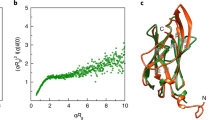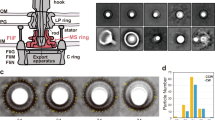Abstract
The interaction between the flagellum specific sigma factor, σ28, and its inhibitor, FlgM, was examined using multidimensional heteronuclear NMR. Here we observe that free FlgM is mostly unfolded, but about 50% of the residues become structured when bound to σ28. Our analysis suggests that the σ28 binding domain of FlgM is contained within the last 57 amino acids of the protein while the first 40 amino acids are unstructured in both the free and bound states. Genetic analysis of flgM mutants that fail to inhibit σ28 activity reveal amino acid changes that are also isolated to the C-terminal 57 residues of FlgM. We postulate that the lack of structure in free and bound FlgM is important to its role as an exported protein.
This is a preview of subscription content, access via your institution
Access options
Subscribe to this journal
Receive 12 print issues and online access
$189.00 per year
only $15.75 per issue
Buy this article
- Purchase on Springer Link
- Instant access to full article PDF
Prices may be subject to local taxes which are calculated during checkout
Similar content being viewed by others
References
Macnab, R.M. & Parkinson, J.S. Genetic analysis of the bacterial f lagellum. Trends Genet. 7, 196–200 (1991).
Trachtenberg, S. & DeRosier, D.J. Three-dimensional structure of the frozen-hydrated flagellar filament. J. Mol. Biol. 195, 581–601 (1987).
lino, T. Polarity of flagellar growth in Salmonella. J. Gen. Microbiol. 56, 227–239 (1969).
Ohnishi, K., Kutsukake, K., Suzuki, H. & lino, T. Gene fliA encodes an alternative sigma factor specific for flagellar operons in Salmonella typhimurium. Mol. Gen. Genet. 221, 139–147 (1990).
Ohnishi, K., Kutsukake, K., Suzuki, H. & lino, T. A novel transcriptional regulation mechanism in the flagellar regulon of Salmonella typhimurium: an anti-sigma factor inhibits the activity of the flagellum-specific sigma factor,σF. Mol. Microbiol. 6, 3149–3157 (1992).
Hughes, K.T., Gillen, K.L., Semon, M.J. & Karlinsey, J.E. Sensing structural intermediates in bacterial flagellar assembly by export of a negative regulator. Science 262, 1277–1280 (1993).
Kutsukake, K. Excretion of the anti-sigma factor through a flagellar substructure couples flagellar gene expression with flagellar assembly in Salmonella typhimurium. Mol. Gen. Genet. 234, 605–612 (1994).
Ruiz, T., Francis, N.R., Morgan, D.G. & DeRosier, D.J. Size of the export channel in the flagellar filament of Salmonella typhimurium. Ultra microscopy 49, 417–425 (1993).
Kay, L.E., Torchia, D.A. & Bax, A. Backbone dynamics of proteins as studied by 15N inverse detected heteronuclear NMR spectroscopy: application to staphylococcal nuclease. Biochemistry 28, 8972–8979 (1989).
Wüthrich, K. NMR of Proteins and Nucleic Acids (Wiley, New York, 1986).
Aizawa, S.I., Vonderviszt, F., Ishima, I. & Akasaka, K. Termini of Salmonella flagellin are disordered and become organized upon polymerization into flagellar filament. J. Mol. Biol. 211, 673–677 (1990).
Bychkova, V.E., Pain, R.H. & Ptitsyn, O.B. The “molten globule” state is involved in the translocation of proteins across membranes. FEBS letts. 238, 231–234 (1988).
Randall, L.L. & Hardy, J.S. Correlation of competence for export with lack of tertiary structure of the mature species: a study in vivo of maltose binding protein in E. coil. Cell 46, 921–928 (1986).
Driessen, A.J. How proteins cross the bacterial cytoplasmic membrane. J. Membr. Biol. 142, 145–159 (1994).
Verner, K. & Schatz, G. Import of an incompletely folded precursor protein into isolated mitochondria requires an energized inner membrane, but no added ATP. EMBO J. 6, 2449–2456 (1987).
Iyoda, S. & Kutsukake, K. Molecular dissection of the flagellum-specific anti-sigma factor, FlgM of Salmonella typhimurium. Mol. Gen. Genet. 249, 417–424 (1995).
Macnab, R.M. Genetics and biogenesis of bacterial flagella. Annu. Rev. Genet. 26, 131–158 (1992).
Casanova, J.-L., Pannetier, C., Jaulin, C. & Kourilsky, P. Optimal conditions for directly sequencing double-stranded PCR products with Sequenase. Nucl. Acids Res. 18, 4028 (1990). (AUTHOR: PAGE RANGE?)
Marion, D., Kay, L.E., Sparks, S.W., Torchia, D.A. & Bax, A. Three-dimensional heteronuclear NMR of 15N-labeled proteins. J. Amer. Chem. Soc. 111, 1515–1517 (989).
Zuiderweg, E.R.P. & Fesik, S.W. Heteronuclear three-dimensional NMR spectroscopy of the inflammatory protein C5a. Biochemistry 28, 2387–2391 (1989).
Cavanagh, J., Chazin, W.J. & Ranee, M. The time dependence of coherence transfer in homonuclear isotropic mixing experiments. J. Magn. Reson. 87, 110–131 (1989).
Marion, D. et al.overcoming the overlap problem in the assignment of 1H NMR spectra of larger proteins by the use of three-dimensional heteronuclear 1H-15N Hartmann-Hahn-multiple quantum coherence and nuclear Overhauser-multiple quantum coherence spectroscopy: application to interleukin 1 beta. Biochemistry 28, 6150–6156 (1989).
Muhandriam, D.R. & Kay, L.E. Gradient-enhanced triple-resonance three-dimensional NMR experiments with improved sensitivity. J. Magn. Reson. B103, 203–216 (1994).
Kay, L.E., Xu, G.Y. & Yamazaki, T. Enhanced-sensitivity triple-resonance spectroscopy with minimal H2O saturation. J. Magn. Res. A109, 129–133 (1994).
Bodenhausen, G. & Ruben, D.J. Natural abundance nitrogen-15 NMR by enhanced heteronuclear spectroscopy. Chem. Phys. Lett. 69, 185–199 (1980).
Kay, L.E., Keifer, P. & Saarinen, T. Pure absorption gradient enhanced heteronuclear single quantum correlation spectroscopy with improved sensitivity. J. Am. Chem. Soc. 114, 10663–10665 (1992).
Author information
Authors and Affiliations
Rights and permissions
About this article
Cite this article
Daughdrill, G., Chadsey, M., Karlinsey, J. et al. The C-terminal half of the anti-sigma factor, FlgM, becomes structured when bound to its target, σ28. Nat Struct Mol Biol 4, 285–291 (1997). https://doi.org/10.1038/nsb0497-285
Received:
Accepted:
Issue Date:
DOI: https://doi.org/10.1038/nsb0497-285
This article is cited by
-
Structural disorder in the proteome and interactome of Alkhurma virus (ALKV)
Cellular and Molecular Life Sciences (2019)
-
Proteases HtrA and HtrB for α-amylase secreted from Bacillus subtilis in secretion stress
Cell Stress and Chaperones (2019)
-
Genome and transcriptome of the natural isopropanol producer Clostridium beijerinckii DSM6423
BMC Genomics (2018)
-
Intrinsically disordered proteins in crowded milieu: when chaos prevails within the cellular gumbo
Cellular and Molecular Life Sciences (2018)
-
Backbone chemical shift assignments for the sensor domain of the Burkholderia pseudomallei histidine kinase RisS: “missing” resonances at the dimer interface
Biomolecular NMR Assignments (2015)



